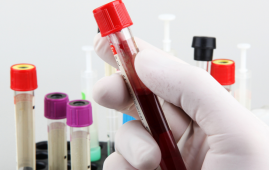

The mechanisms acute myeloid leukemia (AML) cells utilize to manufacture “free radicals”—the consequence of a cell function that aggressively drives the proliferation of cancer cells and restricts the efficacy of current treatments—have been uncovered by Newcastle researchers in a world-first.
The University of Newcastle and Hunter Medical Research Institute (HMRI) researchers also discovered a method to stop leukemia cells from producing free radicals, which would improve the cells’ response to the current therapies used to treat leukemia patients. Their findings were published on March 28 in Science Signaling.
Free radicals, sometimes referred to as reactive oxygen species (ROS), are an expected and required result of cell activity in the human body.
However, excessive or unchecked ROS can harm DNA, cells, and tissues, which can result in illness.
In the case of cancer, malignant cells develop an addiction to ROS and employ its corrosive force to continuously alter cell growth and survival pathways, rendering them nearly intractable. Through the oxidation of proteins needed for energy, cancer cells also use ROS to accelerate their growth.
Associate Professor Mat Dun, a biomedical scientist at the University of Newcastle, noted that although there have been more reports of excessive ROS in cancer in recent years, the precise mechanisms involved have not yet been fully elucidated.
“We set out to investigate the source of ROS in leukemia cells and how ROS influences leukemia cell growth, survival and response to anti-cancer therapies.
Importantly, we believed that if we could identify the way in which ROS was perpetuating the malignancy, we could find a way to mitigate ROS production and control or reduce leukemia cell growth and survival,” he said.
For the first time, the impact of ROS or free radicals on the full “proteome,” or collection of all proteins, in acute myeloid leukemia, has been identified.
Since ROS was thought to be a major factor in practically all types of cancer, Associate Professor Dun stated that their discovery may be useful for treating other types of cancer.
“Anti-cancer drugs typically work by targeting proteins, making our finding highly informative in leukemia research circles, which we hope will translate to improved survival for future leukemia patients.”
The scientists employed a specialized method called “high-resolution proteomic profiling” to carry out the study. Since proteins are what regulate how cells develop and respond to or resist cancer therapies, this involved comparing the variety of proteins found in blood cells from individuals with acute myeloid leukemia to healthy blood cells.
The researchers evaluated how ROS affected proteins in leukemia versus healthy cells with the assistance of their Danish counterparts.
“Our proteomic profiling showed that ROS-affected proteins were more highly expressed in some patients versus others, and, in those with high expression, we identified a genetic mutation common to each sample,” Associate Professor Dun explained.
Proteins identified as being affected in cancer samples are considered a therapeutic vulnerability.
“We knew if we could find or develop drugs that targeted the proteins active or present in the leukemia cells, we could impede cancer’s ability to perpetually grow and survive.”
In partnership with pharmaceutical company GlaxoSmithKline, the team tested its novel, ROS-targeting drug in the leukemia models, discovering leukemia cell growth was impeded. This was particularly the case in models that mimicked drug-resistant types of leukemia.
“If future clinical trials confirm the safety and effectiveness of the ROS-targeting drug, this approach will likely help a large subset of people with acute myeloid leukemia, including those with drug-resistant disease.”
more recommended stories
 Osteoarthritis Genetics Study Uncovers New Treatment Hope
Osteoarthritis Genetics Study Uncovers New Treatment HopeOsteoarthritis- the world’s leading cause of.
 Antibody Breakthrough in Whooping Cough Vaccine
Antibody Breakthrough in Whooping Cough VaccineWhooping cough vaccine development is entering.
 Scientists Unveil Next-Gen Eye-Tracking with Unmatched Precision
Scientists Unveil Next-Gen Eye-Tracking with Unmatched PrecisionEye-tracking technology has long been a.
 Men5CV: Hope for Ending Africa’s Meningitis Epidemics
Men5CV: Hope for Ending Africa’s Meningitis EpidemicsA landmark global health study led.
 Stem Cell Therapy Shows 92% Success in Corneal Repair
Stem Cell Therapy Shows 92% Success in Corneal RepairA groundbreaking stem cell therapy known.
 Gene Therapy for Maple Syrup Urine Disease
Gene Therapy for Maple Syrup Urine DiseaseResearchers at UMass Chan Medical School.
 How Fast Are Your Organs Aging? Simple Blood Test May Tell
How Fast Are Your Organs Aging? Simple Blood Test May TellNew research from University College London.
 HEALEY Platform Accelerates ALS Therapy Research
HEALEY Platform Accelerates ALS Therapy ResearchA New Era of ALS Clinical.
 Low-Oxygen Therapy in a HypoxyStat Pill? Scientists Say It’s Possible
Low-Oxygen Therapy in a HypoxyStat Pill? Scientists Say It’s PossibleA New Approach to Oxygen Regulation-HypoxyStat.
 Early Alzheimer’s Diagnosis with Advanced Tau Test
Early Alzheimer’s Diagnosis with Advanced Tau TestA New Biomarker Test Promises Early.

Leave a Comment